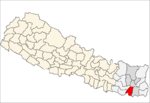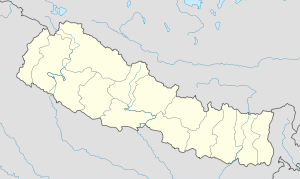- Dharan, Nepal
-
Dharan
धरान— Town — Nickname(s): Dharan Bazar Motto: "To build an environmentally sound city, functioning as the centre of education, health, tourism and business with fully developed infrastructure". Location of Dharan in Nepal Coordinates: 26°49′N 87°16′E / 26.817°N 87.267°ECoordinates: 26°49′N 87°16′E / 26.817°N 87.267°E Country  Nepal
NepalDevelopment Region Eastern Zone Koshi Zone District Sunsari District Area - Total 39.9 sq mi (103.38 km2) - Water 1.7 sq mi (4.4 km2) Population (2007) - Total 118,000 - Ethnicities Rai, Newar, Limbu, Chettri - Religions Hindu, Kirat, Buddhist,Christian Time zone GMT +5:45 Area code(s) 025 Website www.dharan.gov.np Dharan (Nepali: धरान) is a major city in eastern Nepal, in the Sunsari District, situated on foothills of Mahabharat Range with southern tip touching the edge of the Terai at an altitude of 1148 ft (349m). It serves as a trading post between the hilly region and the plains of Terai region. It was once the location of recruitment center for Brigade of Gurkhas , opened in 1953. The recruitment center is closed and the campus is now the home of B.P. Koirala Institute of Health Sciences since 1993. Dharan Municipality organised a Golden Jubilee celebration of Dharan from January 28 to 31 January 2011 marking the 50th year of establishment of the municipality.[1]
Contents
History
Dharan started as a small trading settlements. Over the last couple of decades, the population of Dharan has increased and diversified to include people from various ethnicities like Limbu, Rai, Gurung, Newar, Brahmins, Chhetris etc.
The modern Dharan's foundation was laid in 1902 A.D. by prime minister Chandra Samsher. He established a small village at the foot of Bijayapur hillock and named it Chandranagar (now Purano Bajar). The purpose was to supply timber to East India Company, who in 1890s had expanded its North Eastern territory and was laying railway tracks. The first government official to be appointed in this small village of Chandranagar was Subba Ratna Prasad. A settlement grew steadily over the course of time. This growing settlement was named Juddha Nagar (now Naya Bazaar) after Prime minister Juddha Samsher. It was declared a municipal town in 1960.The British Gorkha Recruit Center was established in 1953 and this increased the flow of people and expansion of the town. Recruits from all over Nepal flocked to join British Gurkha, thereby drastically altering the face of Dharan. There was a surge in population with recruits bringing their families, and others who came to seek employment and exploit business opportunities. As a result, Dharan has emerged as one of the biggest towns in eastern Nepal. It is in true sense a melting pot of different ethnic groups, languages, dialects and religions.
In 1962, Nepal was divided into 14 administrative zones and 75 districts and Dharan was made the zonal headquarters of Kosi Zone. Initially, the town was divided into eleven wards, but in 1980 Banjjhogara Gaon Panchayat at the east (which is now the most developed area of Dharan) and Ghopa Gaon Panchayat at the west were added to Dharan Town Panchayat. This expansion led to the reformation of the wards. Now Dharan is divided into nineteen wards.
Etymology
The name of the city originates from "Dharan", which literally means a place where you saw timber. A typical Dharan is constructed by digging a rectangular plot about 5 to 6 feet deep. This hole is large and deep enough for an adult to comfortably move about. A platform is constructed to cover half the hole. A timber is placed on this platform and two man team, one standing on the platform and the other in the dug out proceed to saw timber with a huge saw blade. This is very labor intensive and dangerous process.
Local Government
The local administration body is the Municipality. Dharan Municipality is headed by an elected mayor. There are 19 electoral wards in Dharan. A corporator is elected in each of the wards, and people of Dharan directly elect the mayor by majority vote
Entertainment/Sports
There are two cinema halls that screen movies in Nepali, English and Hindi. From the very beginning Dharan has been an arena for games and sports. Many of its players have represented Nepal in international competitions. Till now Dharan is a force to recon with in Football, Martial Arts and Cricket. The biggest and probably the best Golf Course of the country (18 hole s) is in Dharan. A Local Football club organizes Budhasubba Gold Cup football Tournament at Dharan Stadium every year. Municipality help this event as a co-organiser.
Tourism
Dharan is a tourist destination in its own right. Communication is mainly in Nepali and English. People who are English speakers should have no problem comprehending many signs and road maps in Nepal.
Beyond Bhedetar lies the eastern hilly district such as Dhankuta, Bhojpur,Phidim, Terathum. Dharan serves as a gateway to some of the remote tourist attractions like Kumbhakarna Himal, Kanchenjunga, Makalu Barun National Park, Arun Valley, Tinjure-Milke (Rhododendron Protection Area), Gupha Lake, Hyatrung Fall, and Sabha Pokhari. They are quite further and therefore require extended day trips.
To the south of Dharan is the city of Biratnagar and connecting towns, all within an hours drive. The towns of Tararah and Itahari are popular with the local population of Dharan.
Dharan, with its diverse population has numerous centers of worship i.e. temples, churches and a mosque. Bijaypur hill is of a particular significance, as it has several temples of importance, such as Dantakali temple, Pindeshwar temple, Budha Subbha temple and Panch Kanya. These temples are of historical and archaeological importance in as much as religious. These temples are centers for rituals, fares and events.
Different ethnic groups host their traditional cultural festivities all year around. The Dhan naach and Chyabrum naach of Limbus, Lakhe naach and Gai jatra of Newars, Sakela Sili naach of Rai people, Selo of Tamangs, Rodighar of Gurungs, Baalan and Sangini of Brahmin and Chhetris, all add to the cultural tradition of Dharan.
Other potential tourism prospects include:
- White water rafting in Tamor river, starting from Tamor to Chatara Ghat.
- Paragliding from surrounding hills and Bhedetar for the dare-devils.
- Development of Panchakanya, a Natural Park into a mini zoo.
- Protection and development of flora and fauna of Chaarkose forest.
- Cable car at Dharan-Bishnupaduka-Baraha Kshetra.
- Better advertisement of Babadham fair.
- Construction of an airport in Dharan.
Some measures taken by the Municipality of Dharan to promote tourism:
- Emphasis on the development infrastructures of the city.
- Support development and management of Pindeshwar Babadham fair, Baraha Kshetra fair and Bishnupaduka fair to promote religious tourism.
- Budhasubba Football Tournaments coordinated by the municipality every year.
- Annual publication of a brochure and city information of Dharan.
- Publication and distribution of postcards and photographs of Dharan and Bhedetar.
- Promote Dharan festivals. E.g. Dharan Mahotsav.
- Dharan Clock Tower.
- Development of the Saptarangi Park (Park of Seven Colours) and Panchakanya Natural Park.
- Financial and other assistance to the development of a privately run Yalambar Park.
Geography
- Surrounded by hills at three directions, Charkose jhadi (Forest) at the south, flanked by two rivers to the east and west which is Seuti river and Shardhu river respectively.
- Temperate climate.
- Great change of altitude at a short distance (305 m to 700 m at a short distance of 4 km.)
- Sloped terrain.
- Mid-point between Hills and the Terai plains (Bhawar region), and a gateway to the hills.
Media
Dharan has two Satellite broadcast television stations.
- Dharan Cable Network
- Space Time Network
The people of Dharan are served by several Daily local newspapers and National Newspapers. There are 11 local newspapers in total. Among all of these, the most popular is The Blast and The Morning Times. National Newspapers are also provide to the people of Dharan on daily basis. Some of the National newspapers are The Kathmandu Post, Kantipur, Annapurna Post,[2][3]Himalayan Times e.t.c. And several monthly neighborhood papers serves the Town.
Radio
Dharan has 5 Radio stations:
Radio Station Name Radio Frequency Radio Nepal/ Rely 648 KHz Star FM 95.6 MHz Bijayapur FM 98.8 MHz Ganatantra FM 94.3 MHz Dantakali FM 88.5 MHz Transport
The easiest way to reach Dharan from abroad is to fly in to the airport at Biratnagar, and then take a bus or some other means of transport to Dharan. Dharan is about 40 km from Biratnagar. It takes 1 hours to reach Dharan from Biratnagar by road. Dharan is connected to Biratnagar by the Koshi Highway- the main highway that runs from Biratnagar to Kimathanka.
There is a transport network bus connecting Dharan to all major cities and local towns. The local transport consists of cars, auto-rickshaws and rickshaws. Sharing a ride with other passengers is the most economical mode of transport.
Education
Dharan boasts of five private colleges and one public university, with more than 40 public and private secondary schools. It also has 9 private and 1 public library and 3 special education centre. It has more than 5 technical school affiliated to CTEVT.
List of Famous Academic Institution
There are several Academic Institutions in the city of Dharan. Some major Academic Institutions in Dharan include:
- Mahendra Multiple Campus, Dharan
- Dharan College of Management(Purbanchal University), Dharan
- Central Campus of Technology(Hattisar)Link label
- Purbanchal Engineering Campus, IOE
- B.P. Koirala Institute of Health Sciences
- Pindeshwor Vidyapeeth (Affiliated to Nepal Sanskrit University)
- Depot Higher Secondary School, Dharan 18 - Estd: 1963 link label
- Delhi Public School
Major Financial Instutions
Major Financial Instutions which serving Dharan are:
- Nepal Bank Limited
- Rastriya Banijya Bank
- Agriculture Development Bank
- Nepal Bangladesh Bank
- Himalayan Bank Limited
- Nabil Bank
- Nepal SBI Bank
- Standard Chartered Bank
- Bank of Asia Nepal Ltd.
Statistics
- It is one of the largest cities of Nepal beside Kathmandu, Biratnagar, Pokhara and Birgunj
- Population: 95,332 (census 2001), of which male 55.514%, female 44.486%, 2007 approx. 118,000
Civic Administration
- Zone: Koshi
- District: Sunsari
- Number of Wards: 19
- Development Region: Eastern Development Region
References
- ^ http://blog.dharan.gov.np/2010/12/2067-14-17.html
- ^ www.clickdharan.com
- ^ http://www.digieel.com
External links
Aekamba, Amaduwa, Amahibelaha, Aurabarni, Babiya, Bakalauri, Barahachhetra, Basantapur, Bhadgau Sinawari, Bhaluwa, Bharaul, Bhokraha, Bishnupaduka, Chadwela, Chhitaha, Chimdi, Dewanganj, Dharan, Dhuskee, Duhabi, Dumaraha, Gautampur, Hanshpokha, Harinagar, Haripur, Itahari, Jalpapur, Kaptanganj, Khanar, Laukahi, Madhelee, Madhesa, Madhuwan, Madhyeharsahi, Mahendranagar, Narshinhatappu, Pakali, Panchakanya, Paschim Kasuha, Prakashpur, Purbakushaha, Ramganj Belgachhi, Ramganj Senuwari, Ramnagar Bhutaha, Sahebganj, Santerjhora, Simariya, Singiya, Sonapur, Sripurjabdi, Tanamuna Categories:
Categories:- Populated places in Sunsari District
Wikimedia Foundation. 2010.

